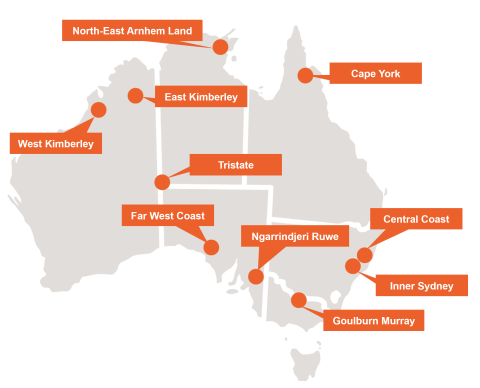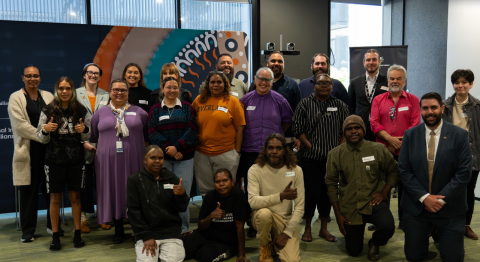Empowered Communities (EC) is a First Nations designed and led partnership with government. Empowered Communities supports Aboriginal and Torres Strait Islander people to share their on-the-ground knowledge with government to shape better decisions that affect them.
Empowered Communities is a way that First Nations people at a local and regional level can speak with government about how investment and policies are working in their communities and how they could work better.
Empowered Communities contributes to the aims of the National Agreement on Closing the Gap, in particular, the 4 Priority Reforms. The Priority Reforms are designed to transform the way governments work with and for First Nations people to improve outcomes.
Over the 10 years it has been in place, Empowered Communities has delivered on the following:
- Priority Reform 1 – Formal Partnerships and Shared Decision Making – EC regions have taken part in shared decision-making on Indigenous Advancement Strategy grants since 2017. Both locally and nationally, Empowered Communities demonstrates the elements of strong partnerships agreed to in the National Agreement on Closing the Gap.
- Priority Reform 2 – Building the Community Controlled Sector – EC opt-in members include many Aboriginal community-controlled organisations (ACCOs) in their region, across a range of sectors. EC supports these ACCOs to take part in shared decision-making. Shared decision-making with EC has also helped shift funding from non-Indigenous to Indigenous-owned service providers.
- Priority Reform 3 – Transforming Government Organisations – Through the Empowered Communities partnership, Government is learning how to work better in partnership and be more responsive to the needs of First Nations people. EC brings forward information that matters to the community. This helps government make sure it is funding services to be safe, respectful, and meet communities’ needs. Empowered Communities is supported at both national and regional levels in the NIAA.
- Priority Reform 4 – Shared Access to Data and Information at a Regional Level – The EC Partnership has helped the NIAA to share more information with EC regions about investment in their region. This includes helping set up data-sharing arrangements with other government agencies such as the Department of Social Services.
10 years of partnership and beyond
The Australian Government has partnered with Empowered Communities since 2015. The NIAA is the lead Government partner for Empowered Communities.
In 2013, First Nations leaders from 8 regions came together to design a new way for First Nations people to work with the government as equal partners.
In 2015, these leaders published the Empowered Communities: Empowered Peoples design report, which shared their plan for change. In response, the Australian Government committed to partner with EC.
Two more regions have joined Empowered Communities since then – Ngarrindjeri Ruwe (SA) in 2018 and Far West Coast (SA) in 2020.
Over 10 years of partnership, Empowered Communities and the NIAA have grown and strengthened their ways of working together.
EC demonstrates strong partnerships between government and communities, both locally and nationally. The EC partnership has grown government staff’s partnership skills. It also supports greater investment in services that are safe, respectful, and meet the needs of the community.
Working in place
There are 10 EC regions across Australia, including urban, rural and remote areas.

Empowered Communities is led by First Nations leaders from each of the 10 regions. They are supported by backbone organisations.
Together, EC Leaders and backbones work with their community to:
- Create plans for their region’s future, called Regional Development Agendas
- Take part in shared decision-making with the Government
- Support local leaders to grow
- Write submissions to Government on issues that matter to their community.
Regional Development Agendas are long-term plans for the region. They include goals for areas such as education, jobs, culture, and health. The plans help First Nations people to tell the government what matters most to them. They test governments to listen to First Nations community priorities.
The Empowered Communities partnership supports strong Aboriginal community-controlled organisations. Through its work in place, Empowered Communities helps highlight how services across areas like health, education and jobs are connected and could work better together. Shared decision-making with EC has also helped shift funding from non-Indigenous to Indigenous-owned service providers.
Shared decision-making
Since 2017, EC has been taking part in shared decision-making with the NIAA on Indigenous Advancement Strategy (IAS) grants. By December 2024, EC had shaped over $411 million of IAS investment across 437 grant activities and applications. This includes the Indigenous Rangers Program and the Indigenous Skills and Employment Program (ISEP).
Shared decision-making helps First Nations people have their ideas heard on what will work best for their local context. It has also helped governments to share better data with communities about funding and investments, making this information clearer and easier to understand for community.
‘I think that [shared decision-making] is one of the best things that have happened. Because previously it was difficult to talk to government and be taken seriously. By being part of the decision-making process, we felt that our opinion was valued.’ – Community member

A key part of the Empowered Communities model is “learning by doing.” In 2024, Empowered Communities and the NIAA commissioned a review to explore the lessons learnt from EC shared decision-making. The review is now available.
You can learn more about EC by visiting the Empowered Communities website or contacting the NIAA Empowered Communities team at Empowered.Communities@niaa.gov.au.